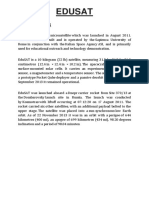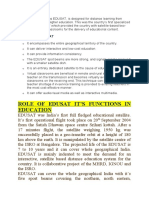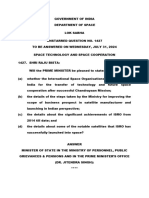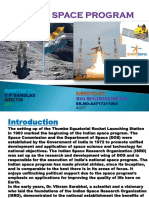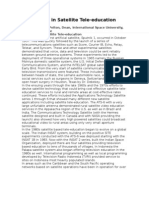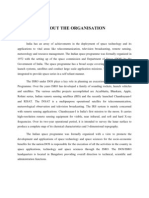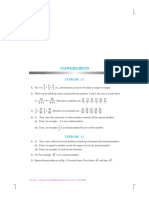0 ratings0% found this document useful (0 votes)
66 viewsIndia Launches Edusat Satellite
India Launches Edusat Satellite
Uploaded by
Chandra Sekhar ReddyIndia successfully launched its first satellite dedicated to education, Edusat, on September 21st. The 1950 kg satellite was launched aboard an Indian Space Research Organisation rocket from Sriharikota spaceport. Edusat will help connect educational institutions across India and address issues like lack of teachers in rural areas by providing distance learning opportunities. It will be able to establish connectivity between urban and rural schools to expand access to education.
Copyright:
© All Rights Reserved
Available Formats
Download as DOCX, PDF, TXT or read online from Scribd
India Launches Edusat Satellite
India Launches Edusat Satellite
Uploaded by
Chandra Sekhar Reddy0 ratings0% found this document useful (0 votes)
66 views2 pagesIndia successfully launched its first satellite dedicated to education, Edusat, on September 21st. The 1950 kg satellite was launched aboard an Indian Space Research Organisation rocket from Sriharikota spaceport. Edusat will help connect educational institutions across India and address issues like lack of teachers in rural areas by providing distance learning opportunities. It will be able to establish connectivity between urban and rural schools to expand access to education.
Original Description:
Edusat
Original Title
Edusat
Copyright
© © All Rights Reserved
Available Formats
DOCX, PDF, TXT or read online from Scribd
Share this document
Did you find this document useful?
Is this content inappropriate?
India successfully launched its first satellite dedicated to education, Edusat, on September 21st. The 1950 kg satellite was launched aboard an Indian Space Research Organisation rocket from Sriharikota spaceport. Edusat will help connect educational institutions across India and address issues like lack of teachers in rural areas by providing distance learning opportunities. It will be able to establish connectivity between urban and rural schools to expand access to education.
Copyright:
© All Rights Reserved
Available Formats
Download as DOCX, PDF, TXT or read online from Scribd
Download as docx, pdf, or txt
0 ratings0% found this document useful (0 votes)
66 views2 pagesIndia Launches Edusat Satellite
India Launches Edusat Satellite
Uploaded by
Chandra Sekhar ReddyIndia successfully launched its first satellite dedicated to education, Edusat, on September 21st. The 1950 kg satellite was launched aboard an Indian Space Research Organisation rocket from Sriharikota spaceport. Edusat will help connect educational institutions across India and address issues like lack of teachers in rural areas by providing distance learning opportunities. It will be able to establish connectivity between urban and rural schools to expand access to education.
Copyright:
© All Rights Reserved
Available Formats
Download as DOCX, PDF, TXT or read online from Scribd
Download as docx, pdf, or txt
You are on page 1of 2
India Launches Edusat Satellite.
On the 21st September, the Indian Space Research Organisation (ISRO)
successfully launched a rocket in to space carrying a 1950 kg satellite dedicated to
the cause of education, 'Edusat'. The rocket was launched from the country's only
spaceport at Sriharikota and placed its payload on a designated orbit, 5000 km away
minutes later.
EDUSAT is the first Indian satellite built exclusively for serving the educational
sector. It is mainly intended to meet the demand for an interactive satellite based
distance education system for the country. It strongly reflects India's commitment to
use space technology for national development, especially for the development of
the population in remote and rural locations.
The 1950 kg EDUSAT was launched into a Geosynchronous Transfer Orbit (GTO)
by ISRO's Geosynchronous Satellite Launch Vehicle (GSLV). From GTO, EDUSAT
will reach the 36,000 km high Geostationary Orbit (GSO) by firing, in stages, its on
board Liquid Apogee Motor (LAM). In GSO, the satellite will be co-located with
KALPANA-1 and INSAT-3C satellites at 74 deg East longitude.
Edusat is expected to have a life of seven years in space, during which it will help
educational institutions make up for, among other things, the dearth of good teachers
by providing connectivity with classrooms far away.
The universalisation of education has become the top priority in India, especially for
the developing countries.
But the extension of quality education to remote and rural regions becomes a
Herculean task for a large country like India with multi-lingual and multi-cultural
population separated by vast geographical distances. There is a lack of adequate
rural educational infrastructure and non-availability of good teachers in sufficient
numbers which adversely affect the efforts made in education.
Compared to other satellites launched in the same series so far, EDUSAT will have
several new technologies.
The spacecraft is built around a standardised spacecraft bus called I-2K. It has a
multiple spot beam antenna with 1.2 m reflector to direct precisely the Ku band spot
beams towards their intended regions of India, a dual core bent heat pipe for thermal
control, high efficiency multi-junction solar cells and an improved thruster
configuration for optimised propellant use for orbit and orientation maintenance. The
satellite uses radiatively cooled Ku-band Travelling Wave Tube Amplifiers (TWTAs)
and dielectrically loaded C-band DEMULTIPLEXER for its communication payloads.
Satellites can establish connectivity between urban educational institutions and a
large number of rural and semi-urban educational institutions to provide an
educational infrastructure.
Besides supporting formal education, a satellite system can facilitate the
dissemination of knowledge to the rural and remote population about important
aspects like health, hygiene and personality development and allow professionals to
update their knowledge base as well.
Thus, in spite of limited trained and skilled teachers, the aspirations of the growing
student population at all levels can be met through the concept of tele-education.
The concept of beaming educational programmes through satellites was effectively
demonstrated for the first time in India in 1975-76 through the Satellite Instructional
Television Experiment (SITE) conducted using the American Application Technology
Satellite (ATS-6).
During this experiment, programmes pertaining to health, hygiene and family
planning were telecast directly to about 2,400 Indian villages spread over six states.
Later, with the commissioning of INSAT system in 1983, a variety of educational
programmes began telecast.
With the success of the INSAT based educational services in the eighties, a need
was felt to launch a satellite dedicated for educational service and the ISRO
conceived the EDUSAT Project in October 2002.
Prime Minister Manmohan Singh congratulated the scientists and engineers, saying
'I am also happy to learn that the GSLV has successfully put into orbit our first
satellite dedicated to education, Edusat, what would provide connectivity to
educational institutions across the country'.
You might also like
- 10 Types of ComputersDocument9 pages10 Types of ComputersChandra Sekhar Reddy50% (2)
- EDUSATDocument7 pagesEDUSATANINDITA RAY100% (1)
- Edusat and TeleconferencingDocument5 pagesEdusat and Teleconferencingparimal deyNo ratings yet
- Information Under RTI Act: Chapter - 1Document71 pagesInformation Under RTI Act: Chapter - 1Kanika ChandNo ratings yet
- EDUSATDocument1 pageEDUSATmihiraNo ratings yet
- EDUSAT1Document6 pagesEDUSAT1Deena BinsonNo ratings yet
- EDUSAT: Conception, Limitations and Success PUNJAB PerspectiveDocument4 pagesEDUSAT: Conception, Limitations and Success PUNJAB PerspectiveJagdev S KalekaNo ratings yet
- Edusat: Educatinal Satellite Presented by-RAKHI BASUDocument8 pagesEdusat: Educatinal Satellite Presented by-RAKHI BASURakhi BasuNo ratings yet
- India in Space A Bag Full of SuccessDocument7 pagesIndia in Space A Bag Full of SuccessIas Aspirant AbhiNo ratings yet
- Role of Edusat It'S Functions in EducationDocument3 pagesRole of Edusat It'S Functions in Educationchama100% (1)
- Gsat-3 (Edusat)Document24 pagesGsat-3 (Edusat)Abhishek Kumar SinghNo ratings yet
- Education and Satellite CommunicationDocument7 pagesEducation and Satellite CommunicationBISWAJIT PATRA100% (1)
- EDUSAT and Its UtilisationDocument7 pagesEDUSAT and Its UtilisationEAO TECHNo ratings yet
- Glimpses of Indian Space ProgramDocument6 pagesGlimpses of Indian Space ProgramVikrant RaghuvanshiNo ratings yet
- EDUSATDocument17 pagesEDUSATANINDITA MALLICKNo ratings yet
- In Conversation With DR K Sivan: Excerpts From Email Interview Given To B.K. Kiranmai, Our Bengaluru RepresentativeDocument4 pagesIn Conversation With DR K Sivan: Excerpts From Email Interview Given To B.K. Kiranmai, Our Bengaluru RepresentativeSudha PandeyNo ratings yet
- SPace and Defence ProgrammeDocument33 pagesSPace and Defence ProgrammeSaba SuhailNo ratings yet
- Insat IRS Launch VehicleDocument12 pagesInsat IRS Launch VehicleEr Vipul NagpalNo ratings yet
- Harness Space Technology For National Development, While Pursuing Space Science Research and Planetary ExplorationDocument32 pagesHarness Space Technology For National Development, While Pursuing Space Science Research and Planetary ExplorationAnonymous yyKEhvhNo ratings yet
- Edusat: Submitted by Alphymol SebastianDocument6 pagesEdusat: Submitted by Alphymol SebastianAlphymol SebastianNo ratings yet
- Indianspaceprogramme 160316050331 PDFDocument17 pagesIndianspaceprogramme 160316050331 PDFMurthyNo ratings yet
- India in SpaceDocument3 pagesIndia in SpacejisstomNo ratings yet
- Loksabhaquestions Annex 182 AU1427 hELdaIDocument7 pagesLoksabhaquestions Annex 182 AU1427 hELdaIRajat GalavNo ratings yet
- Essay On ISRODocument4 pagesEssay On ISROVivek BhardwajNo ratings yet
- Sai Shubhankar: Submitted ToDocument39 pagesSai Shubhankar: Submitted ToPrasad ShahNo ratings yet
- Sci & Tech HandoutDocument8 pagesSci & Tech Handoutmanroopshingh9711No ratings yet
- Isro - Indian Space Research OrganizationDocument13 pagesIsro - Indian Space Research Organizationhamizan maulanaNo ratings yet
- Trends in Satellite TeleDocument3 pagesTrends in Satellite Teleapi-3735701No ratings yet
- Rapid Environmental Impact Assessment (EIA) for Launch Complex at Kulasekharapatnam_NCSCM_Final_19 01 2024_1900hrs (1)Document21 pagesRapid Environmental Impact Assessment (EIA) for Launch Complex at Kulasekharapatnam_NCSCM_Final_19 01 2024_1900hrs (1)ajeeshNo ratings yet
- Sci & Tech HandoutDocument14 pagesSci & Tech Handoutmanroopshingh9711No ratings yet
- Course - B.Ed. (2021-2023) Subject - Innovations in Education Presentation On EDUSATDocument15 pagesCourse - B.Ed. (2021-2023) Subject - Innovations in Education Presentation On EDUSATYashwant Singh Rathore0% (1)
- Space ScienceDocument17 pagesSpace Sciencehuylimala0% (1)
- Essay On Indian Space Research OrganisationDocument4 pagesEssay On Indian Space Research OrganisationVivek BhardwajNo ratings yet
- Unit - V - Satellite - Applications ....Document34 pagesUnit - V - Satellite - Applications ....PrantaNo ratings yet
- Science and Technology Current AffairsDocument38 pagesScience and Technology Current AffairslasyaNo ratings yet
- Achievements in Space ResearchDocument1 pageAchievements in Space ResearchSreekuttan SreejithNo ratings yet
- Satellite Instructional Television Experiment or SITEDocument4 pagesSatellite Instructional Television Experiment or SITEIndira SudharsanNo ratings yet
- WEEK 3 Classification of GNSSDocument3 pagesWEEK 3 Classification of GNSSCydrek EvoraNo ratings yet
- PRAVEEN SIR-s CA 360 SCIENCE AND TECHNOLOGY 2024 - ENGLISH_39663488_2024_09_05_11_40Document55 pagesPRAVEEN SIR-s CA 360 SCIENCE AND TECHNOLOGY 2024 - ENGLISH_39663488_2024_09_05_11_40ShreeNo ratings yet
- Edusat: Gslv-F01 / Edusat (Gsat-3)Document1 pageEdusat: Gslv-F01 / Edusat (Gsat-3)Anjan DebnathNo ratings yet
- Space MissionsDocument3 pagesSpace Missionsdeepak8286No ratings yet
- SST Holiday HomeworkDocument6 pagesSST Holiday Homeworkvrushali patilNo ratings yet
- SST Holiday Homework PDFDocument6 pagesSST Holiday Homework PDFvrushali patilNo ratings yet
- 2020 Science & Technology by AffairsCloudDocument39 pages2020 Science & Technology by AffairsCloudNamita NNo ratings yet
- India Special Space Programme Presses AheadDocument4 pagesIndia Special Space Programme Presses Aheadquaidian06No ratings yet
- Future Projects of Isro: Forthcoming SattelitesDocument5 pagesFuture Projects of Isro: Forthcoming SattelitesAiden PearceNo ratings yet
- Bangabandhu-1 Satellite - Complete Essay For 50 MarksDocument10 pagesBangabandhu-1 Satellite - Complete Essay For 50 MarksSajjad Hossain Shuvo65% (26)
- Indian Space Research OrganisationDocument1 pageIndian Space Research OrganisationBaskar Jk KNo ratings yet
- India Recently Launched Multiple Satellite1Document2 pagesIndia Recently Launched Multiple Satellite1Aagam JainNo ratings yet
- Ics VVMDocument11 pagesIcs VVMkishorereddy_btechNo ratings yet
- Indian Space HistoryDocument12 pagesIndian Space HistoryByomkesh BakshiNo ratings yet
- India Space OddesyDocument6 pagesIndia Space OddesybhavikaNo ratings yet
- Pace Activities in The Country Started During Early 1960s With The Scientific InvestigationDocument3 pagesPace Activities in The Country Started During Early 1960s With The Scientific InvestigationghaneshwerNo ratings yet
- ISRO UpdatedDocument91 pagesISRO Updatedshuklamand29No ratings yet
- A New FrontierDocument3 pagesA New Frontieranon-597812No ratings yet
- About IsroDocument2 pagesAbout IsroVijay GuruNo ratings yet
- BYJUS Exam Prep Gist of Yojana May 2023 - Techade 2023Document20 pagesBYJUS Exam Prep Gist of Yojana May 2023 - Techade 2023diapk.das1996No ratings yet
- Paksitan VS India Space ProgrameDocument7 pagesPaksitan VS India Space ProgrameCHAITUCANo ratings yet
- FeatureDocument3 pagesFeatureAnu AnuNo ratings yet
- India in Space (Updated Edition)From EverandIndia in Space (Updated Edition)Rating: 5 out of 5 stars5/5 (1)
- White Paper on China's Space Activities in 2016From EverandWhite Paper on China's Space Activities in 2016No ratings yet
- NCERT Class 9 Maths Answers and Solutions PDFDocument26 pagesNCERT Class 9 Maths Answers and Solutions PDFNithish RameshNo ratings yet
- 4335ins PDFDocument2 pages4335ins PDFduarehmatNo ratings yet
- Abacus Ten Row Counting GameDocument10 pagesAbacus Ten Row Counting GameChandra Sekhar ReddyNo ratings yet
- Abacus ManualDocument11 pagesAbacus ManualVaishnav KunalNo ratings yet
- YogaDocument47 pagesYogaChandra Sekhar Reddy100% (1)
- Jawahar Navodaya Vidyalaya Selection Test JNVST 2014 Exam Dates and PreviousDocument6 pagesJawahar Navodaya Vidyalaya Selection Test JNVST 2014 Exam Dates and PreviousChandra Sekhar ReddyNo ratings yet
- Possibilities in Polyurethane Synthesis in Their Way To Biomedical ApplicationsDocument1 pagePossibilities in Polyurethane Synthesis in Their Way To Biomedical ApplicationsChandra Sekhar ReddyNo ratings yet
- ICT in Schools For RecordDocument67 pagesICT in Schools For RecordChandra Sekhar ReddyNo ratings yet
- InfraredDocument50 pagesInfraredChandra Sekhar ReddyNo ratings yet
- Sample Experience Certificate Format For School TeacherDocument10 pagesSample Experience Certificate Format For School TeacherChandra Sekhar Reddy59% (17)
- Case Study & Life SkillsDocument14 pagesCase Study & Life SkillsChandra Sekhar Reddy100% (1)

